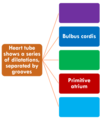Embryo-2 Flashcards
What mesoderm is head mesenchyme, and somites
Paraxial mesoderm
Vertebral column and ribs, meningies
Sclerotome
Striated Muscles
Myotome
Dermatome
Dermis of skin and subcutaneous
What does the splanchinc and somatic lateral plate mesoderm?
Lateral mesoderm
When the lateral Splanchnic and lateral Somatic mesoderm fold together, what is made post lateral folding?
makes the coelom, where the heart cavity, lungs, and ect. are located
What is another name for the yolk sac?
Vitelline Duct, connection from gut tube to the gut tube
What does the endoderm make?
Gut tube
What does the foregut produce?
Trachea esophagus, stomach, duodenum, liver, and pancreas
The small intestine, ascending colon, proximal 2/3 of transverse colon is what part of endoderm?
Midgut
Hindgut is what?
Distal 1/3 of transverse colon, descending colon, rectum, cloacal plate
Cardiovascular system, genitourinary system, smooth and striated muscle, connective tissues, vessels, skeleton, Dermis comes from this layer as well
mesoderm
The ectoderm is what?
epidermis of skin, glands-mammary, sweat, enamel, epithelium, cornea, conjuctiva, lacrimal glands
Adenohypophysis is what?
Lens, inner ear
Neuroectoderm is what?
CNS, Retina, neurohypophysis, and neural crest cells
What is the failure of the thoracic body wall to close?
Ectopia cordis
What is the failure of the abdominal body wall to close?
Gastroschisis





